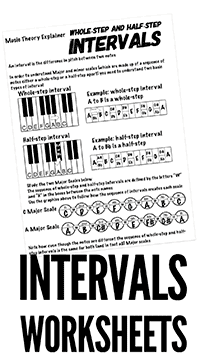Understanding "Whole-Step" and "Half-Step" Intervals
Download the "explainer" shown above now!
Our free "music theory explainers" are a "game-changer"
The music theory explainer document you can see in the graphic above is a great reference for your students. It explains clearly and concisely how the two basic intervals of a whole-step and a half-step combine to construct Major scales. You can distribute them to your learners during classroom sessions. You can also email them or upload them to school or college learning portals or IT systems.
You can also laminate them and put them on the walls of your classroom for "quick reference" for your students during lessons or music workshops

Above you can see a detail of one of the whole-step and half step intervals worksheets
15 Questions on each worksheet
A closer look will let you know that each of the numbered questions on the paper is really three questions They have to write name specified note in the circle provided and then answer two more questions based on the answer that they provided for the first one
When they are at the stage of completing the worksheets without access to the "explainer" document learners are obliged to think in "the abstract" about music theory
In order to answer the questions on the worksheet they will have to have developed a "joined up" knowledge of how notes are named (the subject of topic preceeding this one) and of the fact that black notes on the keyboard can have one of two names assigned to them
Scale Construction is the next stage of study
Notes a whole-step or a half step apart played in a pre-determined sequence and following strict alphabetical order (with sharps and flats utilised where required) are where Major and Minor Scales come from
Download the "explainer" now!

Developing an understanding of all Musical Intervals in the early stages of study can be a daunting subject for the novice musician and it is also unnecessary

Our download does contain more advanced material covering all of the other intervals and you are welcome to pick up a free one by clicking the link below
Printable PDF Music Theory Worksheet on more advanced Intervals
I would stress that the handout covering more advanced material on intervals should not be introduced during the early stages of study
"The only thing our students need to understand in the early stages of study is how whole-step and half-step intervals work"
We study whole-step and half-step intervals at this early stage because an understanding of those two intervals (along with the note naming skills derived from the first two sessions) is all that our students require in order to be able to construct, understand and analyse Major and minor scales.
An understanding of music theory must be built up from solid foundations and before looking at developing an understanding of intervals students must first be confident that they can "correctly" name notes

DOWNLOAD THIS PACK FREE!
FREE DOWNLOAD Pack 3: Whole and Half-Step Intervals 1
An "explainer" and two worksheets looking at whole-step and half step intervals that students will need to understand before they can construct Major and minor scales. As well as being required to graphically recognise and represent individual notes learners are then required to provide the names of notes a whole or half step above or below the one that they originally identified. You can download this pack as a freebie to let you see the quality of our materials and to see where they may fit into your own teaching practice
Download and print this Music Theory Teacher's Pack Free!
To give you an idea of how simple the learning packs are to use you can download the above pack free. Our full download contains 11 more of these learning packs as well as answer sheets for all of the exercises

Pack 4: Whole and Half-Step Intervals 2
Above you can see a detail of one of the worksheets in this learning pack
Another copy of the explainer and two more worksheets to support this crucial aspect of learning how music theory works. When students develop an understanding of whole-step and half-step intervals they are ready to combine the sequence of those intervals that go to make up any major scale
Music Teachers often make a Big Mistake!!!
If the study of whole and half step intervals is neglected or "glossed over" then every other element of basic music theory will seem way more difficult than it needs to be and many students who do not understand the intervals end up deciding that music theory is "too complicated" for them and give up
If that happens to our students then it is our fault!
When I look at the visitor stats for this website (I'm afraid I am sad enough to do that occasionally!) I am dismayed to find that this page (on whole and half step intervals) is one of the least visited of my "main" pages
It seems depressingly reasonable to assume that many music teachers dont realise how important the sublect is Perhaps they feel that intervals are "not a thing" Notes (the subject of step 1) are definately a thing and scales (the subject of step 3) are also certainly a thing It could be that whole and half-step intervals are "the gaps between two things" and as such are not seen as being as important as the material discussed in steps 1 and 3
If you take a look at the graphic above (which is a close up of one of the intervals worksheets) we need to be working towards a situation where our students can confidently and reasonably quickly provide correct answers to the five questions posed within the image
If they develop a functioning ability to do this then the logic that underpins the construction of Major and minor scales (the next topic discussed) will be relatively simple If they fail to develop this ability (or more to the point if we fail to teach them it properly) they will struggle with every other aspect of the harmonic and melodic elements of music theory
Unless a student can be made to understand the two most important intervals (whole and half steps) then they can't be expected to understand how scales work?
If they don't understand scales then they won't be able to grasp chord construction?
If they struggle with chord construction then they are not going to understand
key signatures and diatonic harmony
DOWNLOAD 400+ PDF's NOW!
A lifetime of re-usable resources for only $18.00
$18.00

There Are Another 350 + PDFs In The Download
The Basic Music Theory Course is a very important part of the download but it is only a small part of the story!
There are loads of resources that do use notation as well as a bunch of guitar themed handouts and worksheets
Material covering Blues and Pentatonic scales, 7th chords and inversions We also provide material relating to popular song form
A simple to use"Must have Toolkit" for the modern music educator for less than the price of a single textbook
Our resources are designed to allow you to help students to build a "joined up" knowledge of music theory from a solid grounding in the basics
Our "one click" download consists of 400 professionally prepared handouts and worksheets etc that can be printed over and over again for less than the price of a single paper textbook! many of which deal with the correct identification of intervals
These resources are especially designed to make life easier for classroom music or instrumental teachers who need to get theoretical ideas over to students.
The handouts have been put together so that the same basic ground can be covered with differing levels of graphic support (some handouts feature keyboards and have space for letter names while others aimed at more advanced students rely on a more conventional musical stave approach).
They are designed so that a single music educator might work with all ability levels within a single session. challenging the more able learners whilst supporting those who are not so familiar with the concepts and material under study
musicteachingresources.com is a new sister site of the already well established guitar and bass teacher's resources website teachwombat.com
DOWNLOAD 400+ PDF's NOW!
A lifetime of re-usable resources for only $18.00
$18.00
How to access your simple "one click" download
Buy your music teaching resources in complete safety via any major credit card (through paypal) or directly through your paypal account if you have one. If you choose to use a credit card, rest assured that we never see your credit card details as paypal do all of that for us.
When Paypal receive your payment you will be immediately invited to click a
"RETURN TO MERCHANT"button.
You will be taken to a page from where you can download the products that you have paid for NOW!
In the (rare) event that something should go wrong with the order/download process just email me at robh@teachwombat.com
I will check the order and send you the links that will get you to your stuff.
Cheers! Rob!
Click the picture above to download one of our music theory worksheets base around the recognition of musical intervals

















